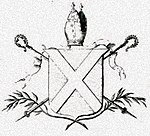David de Bernham
David de Bernham | |
|---|---|
| Bishop of St Andrews | |
 seal of David de Bernham | |
| Church | Roman Catholic Church |
| See | Diocese of St Andrews |
| In office | 1240–1253 |
| Predecessor | William de Malveisin |
| Successor | Abel de Golynn |
| Orders | |
| Consecration | 1240 |
| Personal details | |
| Died | disputed |
David de Bernham (died 1253) was Chamberlain of King Alexander II of Scotland and subsequently, Bishop of St Andrews. He was elected to the see in June 1239, and finally consecrated, after some difficulties, in January 1240. He died at Nenthorn in 1253 and was buried at Kelso.[1] One interesting feature of his life which has left a written record is the fact that as bishop of St Andrews he consecrated a long list of churches in his diocese. These churches are listed by name, together with the dates on which they were consecrated, in the 1240s, in a 13th-century Pontifical now in the Bibliothèque National, Paris (B.N. Latin 1218).

Election and consecration
[edit]On 3 June 1239 David de Bernham was elected Bishop of St Andrews, and on 22 January following was consecrated by the Bishops of Glasgow, Caithness, and Brechin. He at once set about a visitation of his large Diocese, that extended along the East Coast from the Tweed to the Dee; and the Paris Manuscript is the Service Book used for Dedications, while it also contains the roll of his Church Dedications, which were carried on till near the time when his Episcopate closed in 1253.[3]
Details of his dedications
[edit]In his first year, De Bernham was in the southern part of his See, and dedicated Churches at Lasswade on 7 May, Perth (a predecessor of today's St John's Kirk) about a week after, and North Berwick on 8 July. In 1241, also, he was for the most part in the South, in the Counties of Berwick and Haddington, but he first dedicated St Ninian's, near Stirling, on 16 August, and after three months came northwards again, and has Consecrations at Forteviot in Perthshire, and Kinnettles in Forfarshire, the latter on 11 November. The following year is one of great Episcopal activity, and the only time open for attendance at a Provincial Council held in Perth was from near the middle of June to the middle of July. But in the Spring of this year he held a Synod at Musselburgh, where some Canons were enacted. Early in the Spring (14 March) he is at Mid-Calder, to the west of the Pentlands, and two days after dedicates St Cuthbert's, under the shadow of the Castle, in Edinburgh.[3]
References
[edit]- Citations
- ^ Hardy, James (1879). "An Account of Simprin, Berwickshire". History of the Berwickshire Naturalists' Club. 8: 295. Retrieved 12 October 2022.
- ^ Southern 2020.
- ^ a b de Bernham 1885, p. xxi.
- Sources
- Ash, Marinell (June 1974). "David Bernham, Bishop of St Andrews, 1239-1253". The Innes Review. 25 (1): 3–14. doi:10.3366/inr.1974.25.1.3.
- de Bernham, David (1885). The pontifical offices used by David de Bernham, Bishop of S. Andrews. Edinburgh: Pitsligo Press.
 This article incorporates text from this source, which is in the public domain.
This article incorporates text from this source, which is in the public domain. - Dowden, John (1904). "NOTES ON THE SUCCESSION OF THE BISHOPS OF ST. ANDREWS FROM A.D. 1093 TO A.D. 1571. I". Journal of Theological Studies. 4 (16): 603-604.
- Dowden, John (1912). The Bishops of Scotland, being notes on the lives of all the Bishops, under each of the Sees, prior to the Restoration. Glasgow: Maclehose. pp. 14-15.
- Duncan, A. A. M. (2004). "Bernham, David of". Oxford Dictionary of National Biography (online ed.). Oxford University Press. doi:10.1093/ref:odnb/50015. (Subscription or UK public library membership required.)
- Easson, D. E. (1944). The dedications of Bishop David de Bernham. Scottish Church History Society. pp. 97-113.
- Lamont-Brown, Raymond (1990). "St Andrews, Berwickshire, Berwick: a skein of medieval links". History of the Berwickshire Naturalists' Club. 45 (pt1): 10-11.
- Lockhart, William (1892). The Church of Scotland in the thirteenth century; the life and times of David de Bernham of St. Andrews (Bishop) A.D. 1239 to 1253. Edinburgh: W. Blackwood. pp. 17-24.
- Lyon, C. J. (1843). History of St. Andrews, episcopal, monastic, academic, and civil, comprising the principal part of the ecclesiastical history of Scotland, from the earliest age till the present time. Edinburgh: W. Tait. pp. 110-116.
- Mann, Horace K. (1925). The lives of the popes in the early middle ages. Vol. 13. London: K. Paul. pp. 387-389.
- "David of Bernham, bishop of St Andrews (d.1253)". PoMS.
- Southern, Keiran (9 December 2020). "Family finds 15th century gold coins while pulling weeds in garden". Independent.ie.

